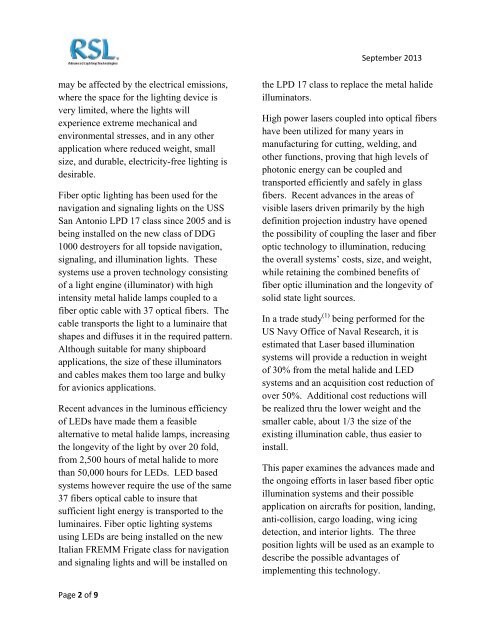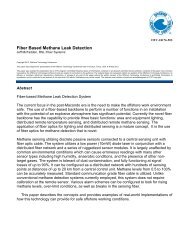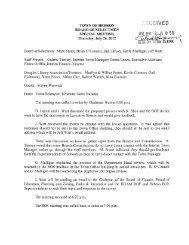Fiber Optic-based Lighting for Aircraft, Giovanni Tomasi, CEO/CTO ...
Fiber Optic-based Lighting for Aircraft, Giovanni Tomasi, CEO/CTO ...
Fiber Optic-based Lighting for Aircraft, Giovanni Tomasi, CEO/CTO ...
Create successful ePaper yourself
Turn your PDF publications into a flip-book with our unique Google optimized e-Paper software.
September 2013<br />
may be affected by the electrical emissions,<br />
where the space <strong>for</strong> the lighting device is<br />
very limited, where the lights will<br />
experience extreme mechanical and<br />
environmental stresses, and in any other<br />
application where reduced weight, small<br />
size, and durable, electricity-free lighting is<br />
desirable.<br />
<strong>Fiber</strong> optic lighting has been used <strong>for</strong> the<br />
navigation and signaling lights on the USS<br />
San Antonio LPD 17 class since 2005 and is<br />
being installed on the new class of DDG<br />
1000 destroyers <strong>for</strong> all topside navigation,<br />
signaling, and illumination lights. These<br />
systems use a proven technology consisting<br />
of a light engine (illuminator) with high<br />
intensity metal halide lamps coupled to a<br />
fiber optic cable with 37 optical fibers. The<br />
cable transports the light to a luminaire that<br />
shapes and diffuses it in the required pattern.<br />
Although suitable <strong>for</strong> many shipboard<br />
applications, the size of these illuminators<br />
and cables makes them too large and bulky<br />
<strong>for</strong> avionics applications.<br />
Recent advances in the luminous efficiency<br />
of LEDs have made them a feasible<br />
alternative to metal halide lamps, increasing<br />
the longevity of the light by over 20 fold,<br />
from 2,500 hours of metal halide to more<br />
than 50,000 hours <strong>for</strong> LEDs. LED <strong>based</strong><br />
systems however require the use of the same<br />
37 fibers optical cable to insure that<br />
sufficient light energy is transported to the<br />
luminaires. <strong>Fiber</strong> optic lighting systems<br />
using LEDs are being installed on the new<br />
Italian FREMM Frigate class <strong>for</strong> navigation<br />
and signaling lights and will be installed on<br />
the LPD 17 class to replace the metal halide<br />
illuminators.<br />
High power lasers coupled into optical fibers<br />
have been utilized <strong>for</strong> many years in<br />
manufacturing <strong>for</strong> cutting, welding, and<br />
other functions, proving that high levels of<br />
photonic energy can be coupled and<br />
transported efficiently and safely in glass<br />
fibers. Recent advances in the areas of<br />
visible lasers driven primarily by the high<br />
definition projection industry have opened<br />
the possibility of coupling the laser and fiber<br />
optic technology to illumination, reducing<br />
the overall systems’ costs, size, and weight,<br />
while retaining the combined benefits of<br />
fiber optic illumination and the longevity of<br />
solid state light sources.<br />
In a trade study (1) being per<strong>for</strong>med <strong>for</strong> the<br />
US Navy Office of Naval Research, it is<br />
estimated that Laser <strong>based</strong> illumination<br />
systems will provide a reduction in weight<br />
of 30% from the metal halide and LED<br />
systems and an acquisition cost reduction of<br />
over 50%. Additional cost reductions will<br />
be realized thru the lower weight and the<br />
smaller cable, about 1/3 the size of the<br />
existing illumination cable, thus easier to<br />
install.<br />
This paper examines the advances made and<br />
the ongoing ef<strong>for</strong>ts in laser <strong>based</strong> fiber optic<br />
illumination systems and their possible<br />
application on aircrafts <strong>for</strong> position, landing,<br />
anti-collision, cargo loading, wing icing<br />
detection, and interior lights. The three<br />
position lights will be used as an example to<br />
describe the possible advantages of<br />
implementing this technology.<br />
Page 2 of 9




